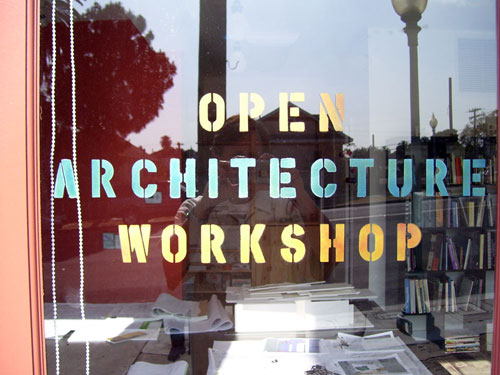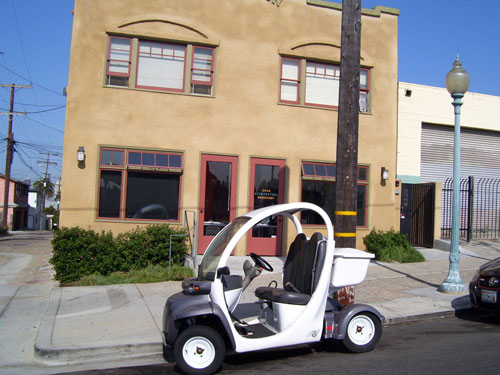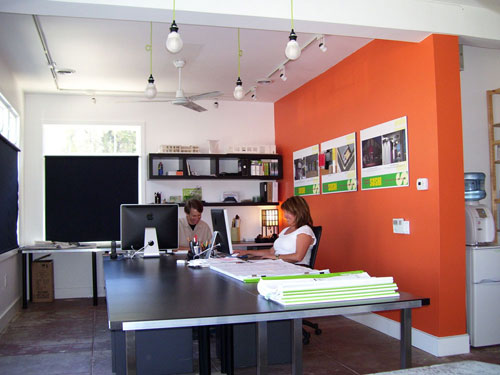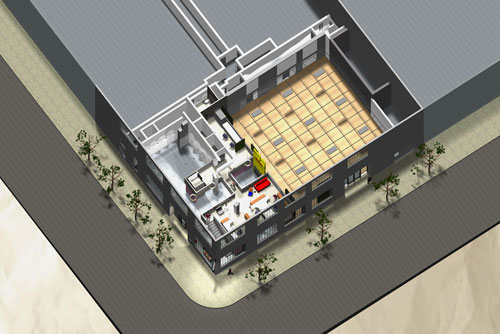Scott Glazebrook founded his company, Open Architecture Workshop, with the goal of bringing the ethos of open source to the practice of architecture. Scott believes that architecture can have an uplifting effect on the community, and he hopes to bring ‘craft’ back to architecture. We are excited to have OAW as part of Harvest’s New Founders Program, and in the following interview Scott explains to us what he means by being ‘open’ in the practice of architecture, shares his visions on how cities across the States can evolve, and talks about their work for a performance and visual art organization in downtown San Diego. We hope you enjoy the interview!
Why and how did you start Open Architecture Workshop?
I started O.A.W. for four fundamental reason – all four are included within of the firm’s primary logo so that we never stray from this mission. First is the goal to create and provide architecture that is more than “green” or “sustainable”; architecture that has as its core the ability to generate greater benefits than it consumes in terms of environment, resources, money, character, and quality. The second goal is to reintegrate the notion and implementation of “craft” back into architecture; not that it has been “lost”, but unnecessarily diminished in an era of “big ideas”. Third on my list was the understanding that the practice of architecture should not be limited solely to the deigns of buildings, but that the techniques and understanding that we as architects have been trained-in and put into practice daily are ideally suited to serve a greater role in our communities to improve the conditions of the environments which we create and live in. Fourth is to open a broader dialog between all involved in a “project”, both directly and indirectly; recognizing that it is only through true collaboration that any of the previous three have a possibility of being accomplished.
Starting was actually kind of easy, you just believe in yourself and your ideals – and go for it. Leaving my previous position as a leader within with a well established and well respected local firm doing good work was the most difficult part.
You put a lot of emphasis on the word ‘Open’. Can you share with our readers what you mean by open?
“Open” is a great word, with so much direct and indirect meaning. Starting with the explicit, “open” is the opposite of closed; which is in part how I am setting this firm apart from others. “Open” means we are collaborative, inclusive, and creative with no preconceived notions about design or the dreaded “s”-word – style. Implicitly, “open” has a lot of meaning to me. During my education and research into architectural theory the ideas of a branch of broader theoretical study, phenomenology as described by Martin Heidegger, intrigued me especially when he described a hypothetical mental-space “opened” by a work of (usually existentialist modern) art where the art’s observer or dweller can achieve what he called “authenticity” which to me means self-respect and fulfillment; a nod to the concept of “real” architecture that focuses on inhabitation and dwelling that can be uplifting and inclusive rather than form-making which can be seen as excluding.
As an architecture studio that champions sustainable design and social responsibility, what do you wish to see more in cities across the United States, in terms architecture and city planning?
I am personally passionate about water. I grew-up in San Diego during the severe water drought in the 70’s, and I remember even at that age being fascinated with how one can save water by making minimal adjustments to a daily routine. Growing-up I spent a lot of time outdoors, and many of these experiences (that I still occasionally enjoy today) where water is THE most important aspect to planning and survival reinforced to me the place of water in human existence. I do not believe, even with today’s droughts throughout the nation, that water resources are valued as much as they should be. I suspect my and later generations have predominantly grown-up completely divorced from water as a daily consumable – instead choosing soda or coffee drinks as a daily staple. But the fact is that water permeates all aspects of our lives whether or not we realize it. And as the general public is becoming familiar with how oil permeates our daily lives beyond just fueling our vehicles, I suspect a new awareness of water is just around the corner. I do have to say that we as a society have a long way to go before we properly assess all natural resources for the true value they provide and the true costs of their consumption at the rates with which we devour them.
I believe we need more accountability from all aspects of the development industry – from planners who take land and artificially create economic value through zoning and regulations, to developers and architects who maximize that inflated economic value often at the expense of the natural value of the land, and back again to the municipalities who enforce the many regulations who are often fearful to make necessary decisions to protect our shared resources. This holds true for natural, societal, and community resources; and is not limited to raw land but also to “under-developed” or “blighted” lands that may be providing a significant societal benefit that is not realized or valued appropriately. This also extends to the invention and implementation of innovative building systems which are extremely difficult to put into practice within existing regulations without discretionary decision-making.
I would like to see more people standing for something larger than themselves or their department or their agency. In the mean time I would like to see these same agencies comprehensively enforcing the regulations and laws already in place – especially here in California – that have been enacted specifically to protect these valuable resources.
What are some essentials tools you use to run your business? Why do you track time, and how does O.A.W. use Harvest?
The most important tool is each of us. Creative solutions and problem solving come from within from experience and education, and through perseverance and rigor. To execute this creativity we use pen and pencil and paper and Xacto knives and cardboard a lot still – but paired with three-dimensional design and documentation software, often referred to today as Building Information Modeling or B.I.M. (pronounced “bim”). I chose ArchiCAD from Graphisoft for a number of reasons, one of the most important is that it is the only such software that is simultaneously developed for Mac and PC, which I feel places it as the international leader and the only truly forward-looking software (though it is definitely the minority in the US for now). Architecture is a profession of providing services through communication, with a whole lot of law thrown-in. And, as architects we hold aesthetics high on a long list of what is important to us and want our tools to “just work” like pencil and paper; which is a significant part of the reason I decided to make this practice Mac-based. Our profession continues a shift that began over a decade ago with greater importance being placed on the communication component of the profession as more people become interested in influencing their environments and get more involved in community design and development organizations; and as traditional project funding models shift to a greater number of shareholders. We send as much time – if not more – tailoring our message to the different stakeholder groups than we do in “pure architecture”; and to design these messages and present them graphically we spend a lot of time working with software tools such as Adobe CS Suite, and to present them through words and numbers we use the Microsoft’s Office Suite.
As a service-based industry, we track time because time is what we “sell” (even though I would prefer to think we sell creativity, quality, value – these things are often initially intangible to clients during the contract negotiation phase). An architect’s work is generally either contracted hourly (with estimate or cap) or with a fixed fee. Either way, the performance of the firm as a whole is dependent on whether the work gets done with in the estimated number of hours and during the estimated calendar timeframe. Harvest provides a simple and elegant way to track time spent on projects (and on internal tasks like marketing), especially though the Dashboard Widget. Expense tracking is also important as we are all at times necessarily working independently on projects and need the flexibility to get what we need when we need it to get the job done and easily reimburse ourselves and pass these costs on to the firm or the client as appropriate. But the most important aspect to Harvest for me, as a business owner, is that I set-up each person a Project Manager so everybody can always see the difference between estimated hours and actual project time. This is great real-time feedback as to how we are performing daily and I think helps us all maintain an attitude of both “authorship” in the work we do and “accountability” for the firm’s success as a whole.
Can you share a couple of projects with our readers?
Given the current economic status, there is not a lot of work out there right now. But we manage to thrive by keeping our costs ridiculously low while maintaining extremely high quality design and service. This allows us to work for clients who otherwise may not be able to afford an architect, but who are often in the most need of one. We are fortunate to be working on only a few projects great right now where we can really focus on the mission of the firm. Though none of them built yet (this takes quite a bit of time), two have begun soft-starts in construction. One of your primary projects is a Tenant Improvement for a long-standing and culturally important downtown nonprofit performance and visual art organization, Sushi Performance and Visual Art, that involves integrating with an existing residential condominium and an historic building exterior.
A rendering of OAW’s design for Sushi Performance and Visual Art.
Another of our primary projects is a complete renovation of an historic hotel, including advanced green technologies, in Needles California that was once part of the famous Harvey House chain of railroad hotels. We are also working on a residential project in an older adjacent-to-downtown neighborhood that has a program of creating a multi-generational family complex where three generations of the same family will be living together and taking care of one another. Other on-going projects and potential projects consist of moderate income for-rent apartments, an artist’s studio, another performance space renovation in The New Children’s Museum here in San Diego, some other residential remodeling work, and some pro bono work with a local elementary school sponsoring a “six-to-six” subsidized daycare program for families where both parents need to work during the day. Plus, I am continuing to teach Environmental Systems at one of our local architecture schools, Woodbury University.
Please share with 5 memorable things you’ve consumed lately.
Starting a business does not leave much time for consuming much more than work, food, an drink right now. But when I do get out, San Diego is a hub for creative brewing and I enjoy a number of the local brews; and two of my favorites are anything from either Stone Brewing (Arrogant Bastard Ale) or Green Flash Brewing (Double I.P.A.). My wife and I are members of a local Community Supported Agriculture (C.S.A.) farm (Be Wise Ranch) and get a bi-weekly selection of local, organically grown vegetables and fruits that continue to broaden our horizons as we explore new recipes (lots of delicious wilted greens); and it really can taste better going organic and local! Speaking of food, there is a great farm-to-market restaurant movement here on San Diego, and at one of our favorites (The Linkery) we recently enjoyed an appetizer of house-cured bacon-wrapped peaches with basil leaf and a little pork belly wrapped-in that was absolutely delicious. Architecture permeates your life, especially when you are married to another; my wife just recently won a Smart Growth Award from the local chapter of the Urban Land Institute for her work on the San Diego Children’s Museum and after the ceremony we enjoyed a great bottle of wine from one of our favorite central-California wineries (Four Vines) at one of our favorite restaurants (The Wine Vault and Bistro). When I am not eating or drinking – or working – I try to spend as much time in the great outdoors that San Diego has to offer; including a two-day hike a few weekends ago in the local Laguna Mountains and kayaking last weekend around Mission Bay.
Thank you for your time, Scott!
To find out more about Open Architecture Workshop and their service, please visit their website.
To help companies get on their feet, The Harvest New Founders Program gives one year’s subscription of Harvest time tracking service to a new company each month. Think you might be a good fit for our New Founders Program? Learn more and apply.



